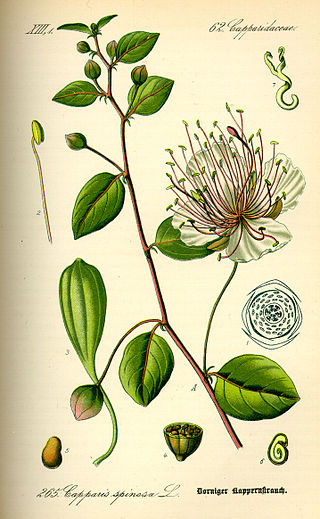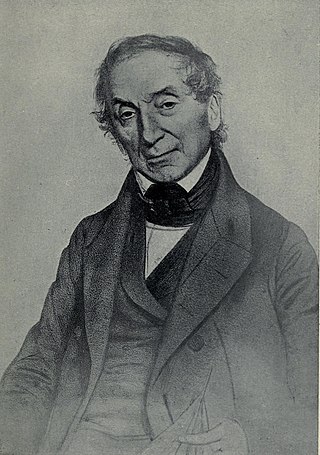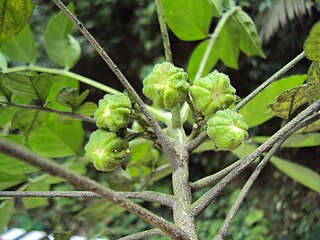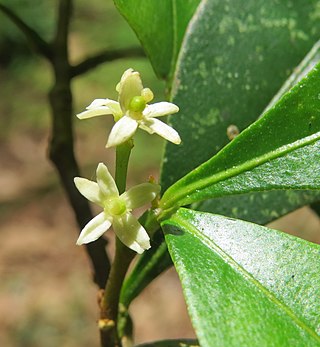
The Isle of Wight is an island, English county and unitary authority in the English Channel, 2 to 5 miles off the coast of Hampshire, across the Solent. It is the largest and second-most populous island in England. Referred to as "The Island" by residents, the Isle of Wight has resorts that have been popular holiday destinations since Victorian times. It is known for its mild climate, coastal scenery, and verdant landscape of fields, downland, and chines. The island is historically part of Hampshire. The island is designated a UNESCO Biosphere Reserve.

Capparis spinosa, the caper bush, also called Flinders rose, is a perennial plant that bears rounded, fleshy leaves and large white to pinkish-white flowers.

The Isle of Wight Festival is a British music festival which takes place annually in Newport on the Isle of Wight, England. It was originally a counterculture event held from 1968 to 1970.

Thomas Caverhill Jerdon was an English physician, zoologist and botanist. He was a pioneering ornithologist who described numerous species of birds in India. Several species of plants and birds including Jerdon's baza, Jerdon's leafbird, Jerdon's bushlark, Jerdon's nightjar, Jerdon's courser, Jerdon's babbler and Jerdon's bush chat are named after him.

Nathaniel Wolff Wallich FRS FRSE was a surgeon and botanist of Danish origin who worked in India, initially in the Danish settlement near Calcutta and later for the Danish East India Company and the British East India Company. He was involved in the early development of the Calcutta Botanical Garden, describing many new plant species and developing a large herbarium collection which was distributed to collections in Europe. Several of the plants that he collected were named after him.

William Roxburgh FRSE FRCPE FLS was a Scottish surgeon and botanist who worked extensively in India, describing species and working on economic botany. He is known as the founding father of Indian botany. He published numerous works on Indian botany, illustrated by careful drawings made by Indian artists and accompanied by taxonomic descriptions of many plant species. Apart from the numerous species that he named, many species were named in his honour by his collaborators.

Robert Wight MD FRS FLS was a Scottish surgeon in the East India Company, whose professional career was spent entirely in southern India, where his greatest achievements were in botany – as an economic botanist and leading taxonomist in south India. He contributed to the introduction of American cotton. As a taxonomist he described 110 new genera and 1267 new species of flowering plants. He employed Indian botanical artists to illustrate many plants collected by himself and Indian collectors he trained. Some of these illustrations were published by William Hooker in Britain, but from 1838 he published a series of illustrated works in Madras including the uncoloured, six-volume Icones Plantarum Indiae Orientalis (1838–53) and two hand-coloured, two-volume works, the Illustrations of Indian Botany (1838–50) and Spicilegium Neilgherrense (1845–51). By the time he retired from India in 1853 he had published 2464 illustrations of Indian plants. The standard author abbreviation Wight is used to indicate this person as the author when citing a botanical name.

Hebomoia glaucippe, the great orange-tip, is a butterfly belonging to the family Pieridae, that is the yellows and whites. It is found in the Indomalayan realm and Wallacea.

The Capparaceae, commonly known as the caper family, are a family of plants in the order Brassicales. As currently circumscribed, the family contains 33 genera and about 700 species. The largest genera are Capparis, Maerua, Boscia and Cadaba.

Elaeocarpus munroi is a species of flowering plant in the Elaeocarpaceae family. It is endemic to the Western Ghats of southern India, in the states of Tamil Nadu, Maharashtra, and Karnataka. It grows in montane evergreen rain forest and shola forest from 600 to 2,000 metres elevation.

Capparis is a flowering plant genus, comprising around 250 species in the family Capparaceae which is included in the Brassicaceae in the unrevised APG II system. These plants are shrubs or lianas and are collectively known as caper shrubs or caperbushes. Capparis species occur over a wide range of habitat in the subtropical and tropical zones.

Hugh Francis Clarke Cleghorn of Stravithie MD, LLD, FRSE, FLS was a Madras-born Scottish physician, botanist, forester and land owner. Sometimes known as the father of scientific forestry in India, he was the first Conservator of Forests for the Madras Presidency, and twice acted as Inspector General of Forests for India. After a career spent in India Cleghorn returned to Scotland in 1868, where he was involved in the first ever International Forestry Exhibition, advised the India Office on the training of forest officers, and contributed to the establishment of lectureships in botany at the University of St Andrews and in forestry at the University of Edinburgh. The plant genus Cleghornia was named after him by Robert Wight.

Murdannia is a genus of annual or perennial monocotyledonous flowering plants in the family Commelinaceae.

Capparis zeylanica is a climbing shrub common in the forests of the Indian subcontinent, Indo-China, China and Malesia; no subspecies are listed in the Catalogue of Life. Several species of Lepidopteran larvae feed on its leaves.

Heterostemma is a genus of plants in the family Apocynaceae, first described in 1834. It is native to India, China, Taiwan, Southeast Asia, Australia, and certain islands in the Pacific.
Phineas Rice Hunt (1816-1878) was an American missionary printer to India and China, under the auspices of the American Board of Commissioners for Foreign Missions (ABCFM). He saw numerous works through his press in Tamil and Mandarin, including New and Old Testaments, a Dictionary of Tamil compiled by Miron Winslow, another dictionary of Tamil by G.U. Pope, Illustrations of Indian Ornithology by Thomas C. Jerdon (1847), and Illustrations of Indian Botany by Robert Wight (1850).

Rungiah aka Rungia or Rungia Raju was a 19th-century Indian botanical illustrator, noted for producing a large number of images for Robert Wight's books on Indian flora. The Raju family were painters of the Kshatriya caste of Tanjore, and were originally from the Telugu-speaking region in the state of Andhra Pradesh.

Munronia is a genus of flowering plants in the family Meliaceae. Its native distribution is tropical and subtropical Asia.

Zanthoxylum ovalifolium, commonly known as thorny yellowwood, oval-leaf yellow wood or little yellowwood, is a species of flowering plant in the family Rutaceae. It is a shrub or tree usually with trifoliate leaves, white, male and female flowers arranged in panicles in leaf axils or on the ends of branchlets and red, purple or brown follicles.

Henry Noltie is a British botanist. He worked as a curator and taxonomist at Royal Botanic Garden Edinburgh.



















